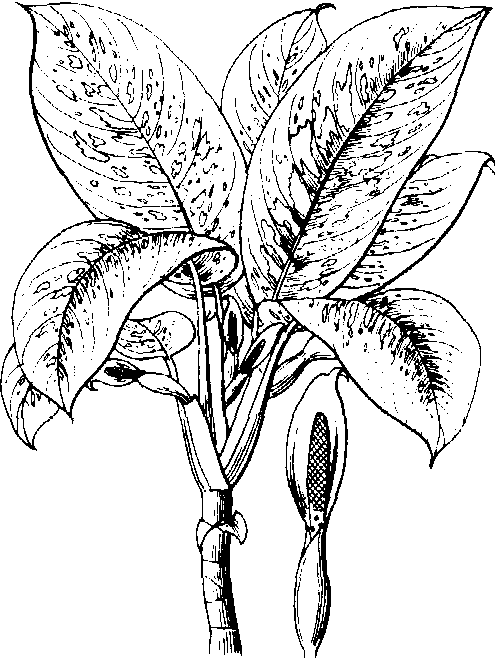花叶万年青variable tuftroot;spotted dieffenbachia
Dieffenbachia picta,别名黛粉叶。天南星科花叶万年青属常绿亚灌木。染色体数2n=2x=16。有木质状的茎,高达1m以上。叶柄有鞘,具亮绿色斑纹;叶片宽椭圆形, 30~60cm长,基部心形,暗绿色,有光泽,具许多不规则的白色或黄色斑点和条纹。花轴短,佛焰苞卵圆形,长约8~10cm,绿色,肉穗花序色浅。变种有:狭叶黛粉叶(var.an-gustior),叶较狭窄,有白色斑纹。白柄黛粉叶(var.barraquiniana),叶柄与中脉白色,叶片有白斑。原产巴西。喜温暖、潮湿、半阴,疏松透水的肥沃土壤。生长适温18~25℃,越冬温度在15℃以上,如温度在10℃以下,则叶片发黄而凋落。用扦插繁殖,将茎于基部2~3节处剪断,留下的茎基仍可发芽,剪下的茎每2~3节为一插穗,插于蛭石或粗砂中,在25~30℃下,20~30天即可生根、发芽。带茎顶的一段泡在28~30℃水中,14天左右生根。花叶万年青是优良的室内观叶植物,适于盆栽作室内布置。其汁液有毒,栽植时慎防汁液接触人体粘膜部分。

本属约30种,常见栽培的还有:巨花叶万年青(D.amoena),也称大王黛粉叶。株高可达2m以上。叶片大,浓绿色,满布黄色斑点。其品种有‘暑白黛粉叶’(cv.Tropic Snow)。鲍斯氏花叶万年青(D.×bau-sei),又称星点黛粉叶。叶片黄绿色,有深绿色斑纹和零星白斑。为花叶万年青与威尔万年青(D.weirii)的杂交种。哑蕉(D.seguina),茎粗壮,绿色。叶柄绿色有白色点纹,叶片卵圆形,基部圆形或心形,先端突然变窄。原产西印度群岛。有许多变种,如油点哑蕉(var.irrorata)、长苞哑蕉(var.litulata)、绿斑哑蕉(var.nobilis)等。白斑花叶万年青(D.×splendens),为李氏花叶万年青(D.leopoldii)和斑点花叶万年青(D.maculata)杂交而成。叶柄有深绿和浅绿条纹,叶脉象牙白色,叶片宝石绿色,有少数白色斑纹。